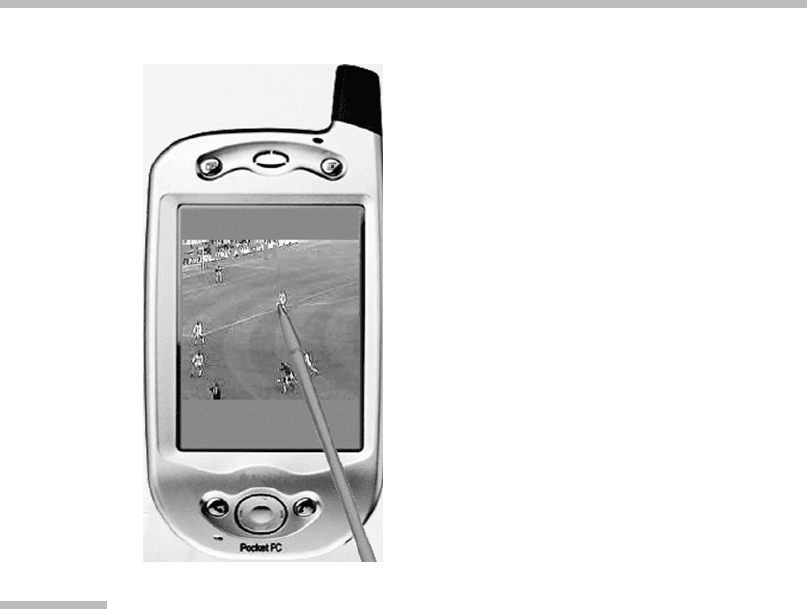Kortum P. (ed.) HCI Beyond the GUI. Design for Haptic, Speech, Olfactory, and Other Nontraditional Interfaces
Подождите немного. Документ загружается.


subject to system “crashes,” which makes its use ideal in safety-critical scenarios
(Cohen & McGee, 2004). These aspects make this medium highly compatible with
mobile field use in harsh conditions.
NISMap is a commercial multimodal application produced by Adapx (
http://
www.adapx.com
) that captures standard military plan fragments and uploads
these plans to standard military systems such as CPOF. Officers operate the sys-
tem by speaking and sketching on a paper map (Figure 12.12). The system inter-
prets military symbols by fusing interpretations of a sketch recognizer and a
speech recognizer. A user may for instance add a barbed-wire fence multimodally
by drawing a line and speaking “Barbed wire.” As an alternative, this command
can be issued using sketch only, by decorating the line with an “alpha” symbol.
The multimodal integration technology used by NISMap is based on Quickset
(Cohen et al., 1997).
NISMap uses digital paper and pen technology developed by Anoto (2007).
Anoto-enabled digital paper is plain paper that has been printed with a special
FIGURE
12.11
Kirusa’s sports demo.
The demo shows the selection of a location while the user commands the
interface to “zoom in” via speech. From
http://www.kirusa.com/demo3.htm
.
(Courtesy Kirusa, Inc.)
12 Multimodal Interfaces: Combining Interfaces
412

pattern, like a watermark. The pattern consists of small dots with a nominal
spacing of 0.3 mm (0.01 inch). These dots are slightly displaced from a grid struc-
ture to form the proprietary Anoto pattern. A user can write on this paper using a
pen with Anoto functionality, which consists of an ink cartridge, a camera in the
pen’s tip, and a Bluetooth wireless transceiver sending data to a paired device.
When the user writes on the paper, the camera photographs movements across
the grid pattern and can determine where on the paper the pen has traveled.
In addition to the Anoto grid, which looks like a light gray shading, the paper itself
can have anything printed on it using inks that do not contain carbon.
12.3.4 Applications of the Interface to Accessibility
Multimodal interfaces have the potential to accommodate a broader range of users
than traditional interfaces. The flexible selection of modalities and the control over
how these modalities are used make it possible for a wider range of users to benefit
from this kind of interface (Fell et al., 1994). The focus on natural means of commu-
nication makes multimodal interfaces accessible to users of different ages, skill
levels, native-language status, cognitive styles, sensory impairments, and other
temporary illnesses or permanent handicaps. Speech can for instance be preferred
by users with visual or motor impairments, while hearing impaired or heavily
accented users may prefer touch, gesture, or pen input (Oviatt, 1999a).
Some multimodal systems have addressed issues related to disability directly.
Bellik and Burger (1994, 1995) have developed multimodal interfaces for the blind.
This interface supports nonvisual text manipulation and access to hyperlinks.
FIGURE
12.12
NISMap application using a digital pen and paper.
Source:
From Cohen and
McGee (2004); courtesy ACM.
12.3 Current Implementations of the Interface
413

The interface combines speech input and output with a Braille terminal and key-
board. Using this interface, users can point to places in the Braille terminal and
command the system via speech to underline words or to select text that can then
be cut, copied, and pasted (Figure 12.13).
Multimodal locomotion assistance devices have also been considered (Bellik
& Farcy, 2 002) . Assistance is prov ided via haptic p resent ation of readings com-
ing from a laser telemeter that detect s distances to objects. Hina et al. (Hina,
Ramdane-Cherif, & Tadj, 2005) present a multimodal architecture that incorpo-
rates a user model which can be configured to account for s pecific disabilities.
This model then dri ves the system interpretations to accommodate individual
differences.
Facetop Tablet (Miller, Culp, & Stotts, 2006; Stotts et al., 2005) is an interface
for the Deaf. This interface allows deaf students to add handwritten and sketched
notes, which are superimposed by a translucent image of a signing interpreter
(Figure 12.14). Deaf students are able to continue to monitor ongoing interpreta-
tion while still being able to take notes. Conventional systems would require
students to move their eyes away from the interpreter, which causes segments
of the interpretation to be lost. Other projects, such as the Visicast and the eSign
Projects (
http://www.visicast.sys.uea.ac.uk/
) address sign language production
via an animated character driven by a sign description notation. The objective
of these projects is to provide deaf users access to government services—for
instance, in a post office (Bangham et al., 2000) or on websites. Verlinden and col-
leagues (2005) employed similar animation techniques to provide for a multimodal
FIGURE
12.13
Braille terminal.
The terminal is in use with a multimodal interface for the blind.
Source:
From
Bellik and Burger (1995); courtesy RESNA.
12 Multimodal Interfaces: Combining Interfaces
414

educational interface, in which graphical and textual information is presented in
synchrony with signing produced by an animated character.
12.4
HUMAN FACTORS DESIGN OF THE INTERFACE
Multimodal interface design depends on finding balance between the expressive
power and naturalness of the language made available to users on the one hand
and the requirements of processability on the other hand. The recognition tech-
nology that multimodal systems depend on is characterized by ambiguities and
uncertainty, which derive directly from the expressiveness of communication that
is offered. Current recognition technology is considerably limited when compared
to human-level natural language processing. Particularly for naı
¨
ve users, the fact
that a system has some natural language capabilities may lead to expectations that
are too high for a system to fulfill.
The challenge in designing multimodal interfaces consists therefore of finding
ways to transparently guide user input in a way that agrees with the limited capabil-
ities of current technology. Empirical evidence accumulated over the past decades
has provided a wide variety of important insights into how users employ multimodal
language to perform tasks. These findings are overviewed in Section 12.4.1, in which
FIGURE
12.14
Facetop Tablet.
Handwritten notes are superimposed with the image of a signing interpreter.
Source:
From Stotts et al. (2005).
12.4 Human Factors Design of the Interface
415

linguistic and cognitive factors are discussed. Section 12.4.2 then presents the princi-
ples of a human-centered design process that can guide interface development.
12.4.1 Linguistic and Cognitive Factors
Human language production, on which multimodal systems depend, involves
a highly automatized set of skills, many of which are not under full conscious con-
trol (Oviatt, 1996b). Multimodal language presents considerably different linguistic
structure than unimodal language (Oviatt, 1997; Oviatt & Kuhn, 1998). Each modal-
ity is used in a markedly different fashion, as users self-select their unique capabil-
ities to simplify their overall commands (Oviatt et al., 1997). Individual differences
directly affect the form in which multimodal constructs are delivered (Oviatt et al.,
2003; Oviatt, Lunsford, & Coulston, 2005; Xiao, Girand, & Oviatt, 2002), influencing
timing and preference for unimodal or multimodal delivery (Epps, Oviatt, & Chen,
2004; Oviatt, 1997; Oviatt et al., 1997; Oviatt, Lunsford, & Coulston, 2005).
Individual Differences in Temporal Integration Patterns
Accumulated empirical evidence demonstrates that users employ two primary
styles of multimodal integration. There are those who employ a predominantly
sequential
integration pattern, while others employ a predominantly
simulta-
neous
pattern (Oviatt et al., 2003; Oviatt, Lunsford, & Coulston, 2005; Xiao
et al., 2002). The main distinguishing characteristic of these two groups is that
simultaneous integrators overlap multimodal elements at least partially, while
sequential integrators do not. In a speech–pen interaction, for example, simulta-
neous integrators will begin speaking while still writing; sequential integrators,
on the other hand, will finish writing before speaking (Figure 12.15).
These patterns have been shown to be remarkably robust. Users can in
most cases be characterized as either simultaneous or sequential integrators by
observing their very first multimodal command. Dominant integration patterns
are also very stable, with 88 to 97 percent of multimodal commands being consis-
tently delivered according to the predominant integration style over time (Oviatt,
Lunsford, & Coulston, 2005). These styles occur across age groups, including
children, adults, and the elderly (Oviatt et al., 2003), within a variety of different
domains and interface styles, including map-based, real estate, crisis manage-
ment, and educational applications (Oviatt et al., 1997; Xiao et al., 2002; Xiao
et al., 2003). Integration patterns are strikingly resistant to change despite explicit
instruction and selective reinforcement encouraging users to switch to a style that
is not their dominant one (Oviatt, Coulston, & Lunsford, 2005; Oviatt et al., 2003).
On the contrary, there is evidence that users further entrench in their dominant
patterns during more difficult tasks or when dealing with errors. In these more
demanding situations, sequential integrators will further increase their intermodal
lag, and simultaneous integrators will more tightly overlap.
12 Multimodal Interfaces: Combining Interfaces
416

Integration patterns are also correlated to other linguistic and performance
parameters. Sequential integrators present more precise articulation with fewer
disfluencies, adopting a more direct command-style language with smaller and
less varied vocabulary. Sequential integrators also make only half as many errors
as simultaneous integrators (Oviatt, Lunsford, & Coulston, 2005).
These strong individual differences in patterns may be leveraged by a system
to better determine which elements should be fused and the appropriate time to
perform interpretation (Section 12.2.3). A system can reduce the amount of time
that it waits for additional input before interpreting a command when dealing with
simultaneous integrators, given prior knowledge that these users primarily over-
lap their inputs. More recently, integration patterns have been exploited within
a machine learning framework that can provide a system with robust prediction
of the next input type (multimodal or unimodal) and adaptive temporal thresholds
based on user characteristics (Huang et al., 2006).
Redundancy and Complementarity
Multimodal input offers opportunities for users to deliver information that is
either
redundant
across modalities, such as when a user speaks the same word
she is handwriting, or
complementary
, such as when drawing a circle on a map
and speaking, “Add hospital.” Empirical evidence demonstrates that the dominant
theme in users’ natural organization of multimodal input to a system is comple-
mentarity of content, not redundancy (McGurk & MacDonald, 1976; Oviatt,
2006b; Oviatt et al., 1997; Oviatt & Olsen, 1994; Wickens, Sandry, & Vidulich,
1983). Users naturally make use of the different characteristics of each modality
“Let’s have an evacuation route”
“Make a route”
0.0 0.5 1.0 1.5 2.0
Time (seconds)
2.5 3.0 3.5
FIGURE
12.15
Model of the average temporal integration pattern for simultaneous and
sequential integrators’ typical constructions.
Top:
Simultaneous integrator.
Bottom:
Sequential integrator.
Source:
From Oviatt,
Lunsford, and Coulston (2005); courtesy ACM.
12.4 Human Factors Design of the Interface
417

to deliver information to an interface in a concise way. When visual-spatial con-
tent is involved, for example, users take advantage of pen input to indicate loca-
tion while using the strong descriptive capabilities of speech to specify temporal
and other nonspatial information. This finding agrees with the broader observa-
tion by linguists that during interpersonal communication spontaneous speech
and manual gesturing involve complementary rather than duplicate information
between modes (McNeill, 1992).
Speech and pen input expresses redundant information less than 1 percent of
the time even when users are engaged in error correction, a situation in which
they are highly motivated to clarify and reinforce information. Instead of relying
on redundancy, users employ a contrastive approach, switching away from the
modality in which the error was encountered, such as correcting spoken input
using the pen and vice versa (Oviatt & Olsen, 1994; Oviatt & VanGent, 1996).
Preliminary results indicate furthermore that the degree of redundancy is
affected by the level of cognitive load users encounter while performing a task
(Ruiz, Taib, & Chen, 2006), with a significant reduction in redundancy as tasks
become challenging. The relationship of multimodal language and cognitive load
is further discussed in following sections.
While complementarity is a major integration theme in human–computer
interaction, there is a growing body of evidence pointing to the importance of
redundancy in multiparty settings, such as lectures (Anderson, Anderson et al.,
2004; Anderson, Hoyer et al., 2004) or other public presentations during which
one or more participants write on a shared space while speaking (Kaiser et al.,
2007). In these cases, a high degree of redundancy between handwritten and
spoken words has been found. Redundancy appears to play a role of focusing
the attention of a group and helping the presenter highlight points of importance
in her message. Techniques that leverage this redundancy are able to robustly
recover these terms by exploiting mutual disambiguation (Kaiser, 2006).
Linguistic Structure of Multimodal Language
The structure of the language used during multimodal interaction with a computer
has also been found to present peculiarities. Users tend to shift to a locative-
subject-verb-object word order strikingly different from the canonical English
subject-verb-objective-locative word order observed in spoken and formal textual
language. In fact, the same users performing the same tasks have been observed to
place 95 percent of the locatives in sentence-initial positions during multimodal inter-
action and in sentence-final positions when using speech only (Oviatt et al., 1997).
The propositional content that is transmitted is also adapted according to
modality. Speech and pen input consistently contribute different and complemen-
tary semantic information—with the subject, verb, and object of a sentence typi-
cally spoken and locative information written (Oviatt et al., 1997).
Provided that a rich set of complementary modalities is available to the users,
multimodal language also tends to be simplified linguistically, briefer, syntactically
simpler, and less disfluent (Oviatt, 1997), containing less linguistic indirection
12 Multimodal Interfaces: Combining Interfaces
418

and fewer co-referring expressions (Oviatt & Kuhn, 1998). These factors contrib-
ute to enhanced levels of recognition in multimodal systems when compared to
unimodal (e.g., speech-only) interfaces.
Pen input was also found to come before speech most of the time (Oviatt et al.,
1997), which agrees with the finding that in spontaneous gesturing and signed
languages, gestures precede spoken lexical analogs (Kendon, 1981; Naughton,
1996). During speech and three-dimensional–gesture interactions, pointing has
been shown to be synchronized with either the nominal or deictic spoken expres-
sions (e.g., “this,” “that,” “here”). The timing of these gestures can be furthermore
predicted in a time window of 200 to þ400 milliseconds around the beginning of
the nominal or deictic expression (Bourguet, 2006; Bourguet & Ando, 1998).
Choice of Multimodal and Unimodal Input
Only a fraction of user commands are delivered multimodally, with the rest
making use of a single modality (Oviatt, 1999b). The number of multimodal com-
mands depends highly on the task at hand, and on the domain, varying from 20 to
86 percent (Epps et al., 2004; Oviatt, 1997; Oviatt et al., 1997; Oviatt, Lunsford, &
Coulston, 2005), with higher rates in spatial domains. Figure 12.16 presents a
graph showing the percentage occurrence of multimodal commands across various
tasks and domains.
Specify
constraint
Over-
lays
Locate Print Scroll
Control
task
Zoom Label Delete Query
Calculate
distance
Modify Move Add
80
70
60
50
40
30
20
10
0
General action commands
Selection commands
Spatial location commands
Percentage of constructions
FIGURE
12.16
Percentage of commands that users expressed multimodally as a function
of type of task command.
Negligible levels can be observed during general commands, with increasing
levels for selection commands and the highest level for location commands
(Oviatt, 1999b); courtesy ACM.
12.4 Human Factors Design of the Interface
419

Influence of Cognitive Load
An aspect of growing interest is the relationship between multimodality and
cognitive load. One goal of a well-designed system, multimodal or otherwise,
should be to provide users with means to perform their tasks in a way that does
not introduce extraneous complexity that might interfere with performance
(Oviatt, 2006a). Wickens and colleagues’ cognitive resource theory (1983) and Bad-
deley’s theory of working memory (1992) provide interesting theoretical frame-
works for examining this question and its relations to multimodal systems.
Baddeley (1992) maintains that short-term or working memory consists of multi-
ple independent processors associated with different modes. This includes a
visual-spatial “sketch pad” that maintains visual materials such as pictures and dia-
grams in one area of working memory, and a separate phonological loop that
stores auditory-verbal information. Although these two processors are believed
to be coordinated by a central executive, in terms of lower-level modality proces-
sing they are viewed as functioning largely independently, which is what enables
the effective size of working memory to expand when people use multiple modal-
ities during tasks (Baddeley, 2003).
Empirical evidence shows that users self-manage load by distributing informa-
tion across multiple modalities (Calvert, Spence, & Stein, 2004; Mousavi, Low, &
Sweller, 1995; Oviatt, Coulston, & Lunsford, 2004; Tang et al., 2005). As task com-
plexity increases, so does the rate at which users choose to employ multimodal
rather than unimodal commands (Oviatt et al., 2004; Ruiz et al., 2006). In an experi-
ment with a crisis management domain involving tasks of four distinct difficulty
levels, the ratio of users’ multimodal interaction increased from 59.2 percent during
low-difficulty tasks to 65.5 percent at moderate difficulty, 68.2 percent at high,
and 75.0 percent at very high difficulty—an overall relative increase of 27 percent.
Analysis of users’ task-critical errors and response latencies across task difficulty
levels increased systematically and significantly as well, corroborating the mani-
pulation of cognitive-processing load (Oviatt et al., 2004). In terms of design, these
findings point to the advantage of providing multiple modalities, particularly in
interfaces supporting tasks with higher cognitive demands.
12.4.2 A Human-Centered Design Process
Given the high variability and individual differences that characterize multimodal
user interaction, successful development requires a user-centered approach. Rather
than relying on instruction, training, and practice to make users adapt to a system,
a user-centered approach advocates designing systems based on a deeper under-
standing of user behavior in practice. Empirical and ethnographic work should pro-
vide information on which models of user interaction can be based. Once users’
natural behavior is better understood, including their ability to attend, learn, and
perform, interfaces can be designed that will be easier to learn, more intuitive,
and freer of performance errors (Oviatt, 1996b, 2006).
12 Multimodal Interfaces: Combining Interfaces
420

While the empirical work described in the previous section has laid the foun-
dation for the development of effective multimodal interfaces, there is still a need
for careful investigation of the conditions surrounding new applications. In the
following sections, steps are described that can be followed when investigating
issues related to a new interface design. The process described here is further illu-
strated by the online case study (see Section 12.7). Additional related considerations
are also presented as design guidelines (Section 12.6).
Understanding User Performance in Practice
A first step when developing a new multimodal interface is to understand the
domain under investigation. Multimodal interfaces depend very heavily on lan-
guage as the means through which the interface is operated. It is important there-
fore to analyze the domain to identify the objects of discourse and potential
standardized language elements that can be leveraged by an interface.
When analyzing a battle management task, for example, McGee (2003) used
ethnographic techniques to identify the language used by officers while working
with tangible materials (sticky notes over maps). When performed in a laboratory,
this initial analysis may take the form of semistructured pilots, during which sub-
jects perform a task with simulated system support. That is, to facilitate evolution,
a simulated (“Wizard of Oz”) system may be used (see Section 12.5.2 for additional
details).
Identification of Features and Sources of Variability
Once a domain is better understood, the next step consists of identifying the
specifics of the language used in the domain. In specialized fields, it is not un-
common for standardized language to be employed. The military employs well-
understood procedures and standardized language to perform battle planning
(McGee & Cohen, 2001; McGee et al., 2001). Similarly, health professionals (Cohen
& McGee, 2004) and engineers have developed methods and language specific to
their fields.
Even when dealing with domains for which there is no standardized lan-
guage, such as photo tagging, the analysis of interactions can reveal useful robust
features that can be leveraged by a multimodal interface. In a collaborative photo
annotation task in which users discussed travel and family pictures, analysis
revealed that the terms that are handwritten are also redundantly spoken. As a
user points to a person in a photo and handwrites his name, she will also in most
cases speak the person’s name repeatedly while explaining who that is. Further
analysis revealed that redundantly delivered terms were frequent during the dis-
cussion and that they were good retrieval terms (Barthelmess, Kaiser et al., 2006;
Kaiser et al., 2007).
Many times languages and features identified during this phase prove too
complex to be processable via current technology. An important task is therefore
to recognize and model the sources of variability and error (Oviatt, 1995).
12.4 Human Factors Design of the Interface
421
